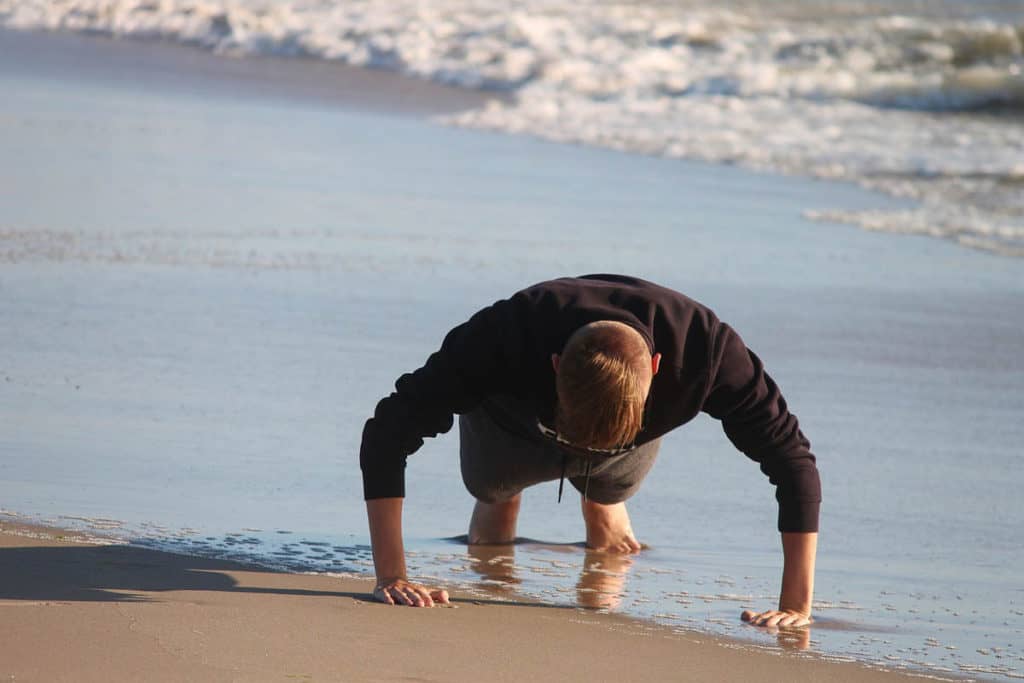Magnetic resonance scanning is a diagnostic technique that uses a magnetic field to image different parts of the body. The imaging procedure is used to pinpoint the location and extent of multiple sclerosis, stroke, infection, sports injuries, and fractures. Can you exercise before an MRI scan?
You can exercise before an MRI, provided it’s a mild to moderate workout a few days before the scan. Doctors recommend refraining from all physically strenuous activities 48 hours before an MRI. That means then; all your workout routines should be done 24 hours before the imaging test.

Why is Strenuous Exercise Not Recommended Before an MRI?
All forms of high-impact physical activity shortly before an MRI scan can interfere with the results of the diagnosis, resulting in false positives. That simply means that the experts may find other ‘abnormalities’ from the test that do not relate to your pain or dysfunction. These abnormal MRI scans result from intense muscle activity and changes shortly before the testing.
Athletes with injuries should, therefore, take it slow before the MRI, or inform the doctor in advance if they plan to keep up with their workout routines. When doctors know about your recent physical activities, they will watch out for false positives in MRI, so that you don’t go under the knife for no reason.
Interpreting MRI Scans is Hard with Recently Bulged Muscles
All forms of workouts increase the size of the muscle groups engaged in the activity. If the muscular activity and growth happen around the location of your pain or injury, it leads to asymmetrical MRI images that are harder to read. This problem is most common around the biceps and gluteus muscles.
Exercise and Contrasting agents Don’t Mix
Most MRI scans can be performed with no injection of contrast agents. However, when doctors want to get a clear image of your condition or injury in tissues, they may often need to inject you with contrasting agents such as gadolinium and glucose. This is done right before the imaging test to help them obtain a much clearer picture of your body.
Muscles exercised shortly before an MRI scan will take up more glucose. Cancer cells behave the same way, and so that makes it hard for doctors to make the right distinction. Increased physical activity before an MRI scan could, therefore, lead to a misdiagnosis.
The Right Exercise Routines Before an MRI
Walking
Walking is still a workout, but not as high impact as running. The goal is to have little muscle changes in your gluteus muscles, as hinted before. Doing a light morning and evening walk can, therefore, help you stay active without necessarily jeopardizing the accuracy of your MRI scan. Then again, if you have a sports injury around the leg region, light walking limits the strain that you would put on it in other forms of cardio.

Stretching
You probably have never categorized stretching as a workout. Stretching may be your warm-up or cool down on regular days, but you might have to stick with it as your main workout shortly before your scan. Stretching will have minimal impact on your muscular composition. Even so, it will help with your flexibility and loosen your muscles so that you can hit the ground running after your MRI scan.
Swimming
Swimming can help with your endurance and cardiovascular strength without having a significant impact on your MRI scans. The workout routine is ideal for those trying to recover from sports injuries. Since all your muscles are used in swimming exercises, your body’s reaction to pre-MRI contrasting agents will be unbiased, helping doctors to do accurate readings.
Dancing
We all hit the gym for various reasons. Sometimes it’s nothing to do with building muscles but about feeling good. Indeed, working out excites your body to produce feel-good hormones that help with mood stabilization. Now, should you miss on that cocktail of happy hormones just because you are going under the MRI machines?
You don’t have to. You can dance. Dancing is a mild workout that also guarantees you a rush of good feelings. When doctors cross out the things you should not do before an MRI, dancing is rarely a part of them. That means then that you can turn up the volume and burn some calories even as you get ready for medical imaging.
Trim Trails
Trim trails can be an excellent gym alternative as you prepare for your MRI. These outdoor workout areas have machines that target different parts of the body, including the chest, torso, and hips. These playgrounds are also much more affordable than gym sessions while offering you the advantage of being in the great outdoors.
Yoga
Yoga is mostly about mindfulness and balance than it is about building muscles. You can, therefore, safely take on a few yoga classes before your MRI appointment. Focus on postures that involve minimal movement and stretching. Listen to your body and go with the flow. Mild and low impact as yoga is, it has the same benefits as other physical workouts, including stress relief and weight loss.
Tai Chi
One other fitness routine that you can borrow from the East in readiness for your MRI is Tai Chi. It involves slow and controlled movements that enhance cardio fitness and calorie burning. It also boosts balance and flexibility.

House Chores
Work on your lawn, do a bit of spring cleaning, or any other major house chore that you have been putting off. Now you have the time because you don’t have to go to the gym. These house chores might be easy but are deceptively engaging for your whole body and might help you stay in the form before and after the MRI and medical treatment.
Bowls
Bowling is for everyone, regardless of age and health status. It’s a physical activity tied in a game. It’s not energetic, but it will sure work out your balance, posture, and flexibility. Bowling is a chance to keep active when you have to slow down due to medical reasons. It allows you to get out there, meet with people, and dig in the same feel-good hormones as your buddies are enjoying at the gym.
How to exercise before an MRI
Keep Everything slow
Cut down on the number of repetitions in your routines. Focus on motion, flexibility, and balance as opposed to strength training. The goal is to keep the body in the ‘mood’ for the workout. That way, when you have to increase the tempo after recovery, you won’t start from ground zero.

Get Enough Rest
Schedule your workout so that you get to rest on the day of the imaging. That will help you to meet the doctor’s recommended hours of muscular inactivity for accurate imaging scans.
Focus on Improving Your Mood
Your light workout before an MRI should focus on enhancing your mood and keeping your body in motion. This is not the time to look at your muscle gain or weight loss results. It might be hard to take your eyes off these goals for a few days, but there is lots of fun to be had in light exercises well.
Stay Safe when Exercising
MRIs are useful in the detection of a variety of conditions, but sports injuries make the majority of these. Watch out, therefore, not to aggravate your injury or fracture when you work out before MRI and treatment. When exercising before an MRI, listen to your body. Stop if you experience pain, discomfort, lightheadedness, and irregular heartbeat.
Do not Work Out an Injured Body Part
Do you have a localized fracture or pain in your legs, back, or upper body? Find an exercise routine that works in another area of your body and not these areas of your injury.

Activated chest muscles, for instance, will have little to the negligible impact of an MRI scan on your lower back. Taking the focus away from your area of injury and pain also helps to minimize further damage to those areas.
Cooldown
You want to be able to reduce your muscle tension after a workout before going in for an MRI. Stretching exercises will do the trick. Cooldowns accelerate your body’s pace of recovering from the workout so that post-workout muscular activity does not interfere with MRI scan results.
Hydrate
Hydration will be among your doctor’s instructions on the things to do before an MRI. Drink plenty of water. Your body needs hydration to stay healthy and perform optimally. Hydration may also help to reduce muscular contractions during the test, helping to reduce the risk of false positives.

Conclusion
It is advisable to skip a workout in the hours leading to your MRI scan. Before that, however, you can try a variety of low-impact moderate exercises. Reducing the intensity and duration of your workout will help you stay active and fit on your road to testing, treatment, and recovery. When you exercise before an MRI, focus on flexibility and balance as opposed to muscle building. Listen to your body; take it slow with every routine and shift focus away from the area of your injury or pain.



